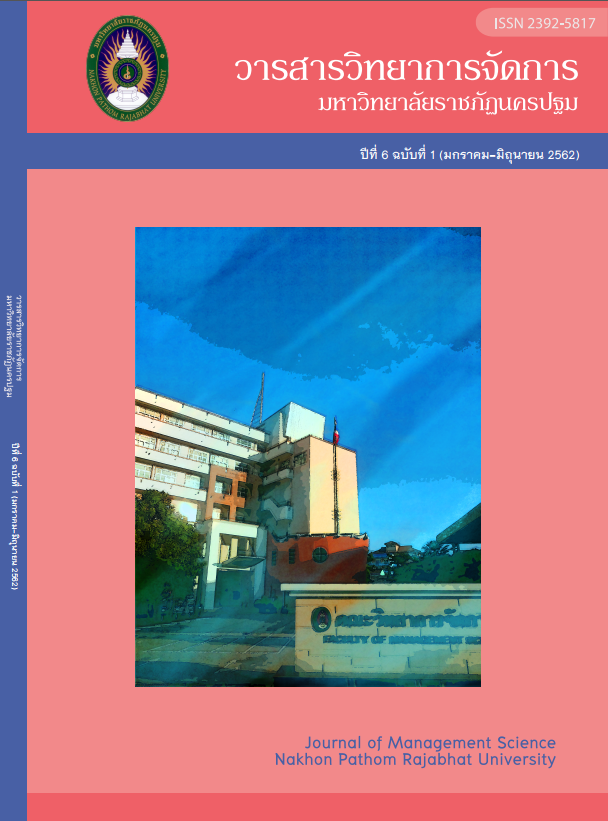Participation Patterns on Hot Spring Sites Tourism Management in Western Thailand.
Main Article Content
Abstract
This research aimed to study the tourism management in hot spring sites in the western Thailand. The study was conducted using qualitative approach, in collaboration with participation from local communities. The fieldwork combines varied sources of data gathering techniques including in-depth interviews, focus groups, surveys, and observations. The samples were stakeholders in relation to tourism development such as governmental organizations, entrepreneurs, local shop owners, community leaders and members, and individual persons relevant to management of three hot spring destinations in western Thailand. The collected data from interviews were analyzed, interpreted and reported using content analysis and descriptive explanation methods.
The results showed that:
1) There were three sites that were different from each other: 1) be managed by local community; 2) be managed by sub-district organization and 3) be managed by forestry department.
2) All of the three hot spring sites, in fact, were outstanding in terms of their local identities and natural resources which were suitable for developing into tourism destinations. However, they were not deeply focused to be used for health tourism at the sites.
3) In terms of tourism patterns, the three sites are considered as health tourism destinations which combined health tourism activities with other tourism resources and activities both in the area and nearby destinations in order to encourage the use of hot springs in each site.
4) The models for local participation and hot spring health tourism development in each study sites were different depending on the organizations that manage the area. For example, some sites were took care by the national park. Some were controlled by the Tambon Administration Organization (TAO). And some were locally managed by the community members. As a result the levels of participation in each site were different. For the one managed by local community, participation level of local residents is higher than the other authorities, for instance.
Moreover, a hot spring tourism master plan should be launch as a guideline for tourism planning and management of hot spring destinations throughout Thailand. This master plan will help each destination to better plan and set the appropriate direction of hot spring tourism development which will benefit to the sustainability of the resources and the conservation of local identity and uniqueness.
Article history : Received 8 July 2018
Revised 1 September 2018
Accepted 5 September 2018
SIMILARITY INDEX = 1.77
Article Details
The views and opinions of the article appearing in this journal are those of the author. It is not considered a view and responsibility of the editorial staff.
References
การท่องเที่ยวแห่งประเทศไทย.(2551). โครงการสำรวจระดับความรับรู้การท่องเที่ยวเชิงสุขภาพของประเทศไทย. กรุงเทพฯ : ฝ่ายนโยบายวางแผน กองวางแผนการท่องเที่ยวฯ.
กรมทรัพยากรธรณี. (2530). รายงานการสำรวจฉบับที่ 1แหล่งพลังงานความร้อนใต้พิภพทางภาคเหนือของประเทศไทย. กรุงเทพฯ : กรมทรัพยากรธรณี
ทวีทอง หงส์วิรัฒน์. (2557). การมีส่วนร่วมของประชาชน. กรุงเทพฯ: มหาวิทยาลัยมหิดล. ศูนย์ศึกษานโยบายสาธารณสุข.
นรินทร์ชัย พัฒนพงศา. (2547). การมีส่วนร่วม หลักพื้นฐานและเทคนิค และกรณีตัวอย่าง. เชียงใหม่: สิริลักษณ์การพิมพ์.
นเรศ สงเคราะห์สุข. (2541). จากแนวคิดสู่การปฏิบัติ เสี้ยวหนึ่งของประสบการณ์พัฒนาแบบมีส่วนร่วมบนพื้นที่สูง. เชียงใหม่ : สำนักพิมพ์เชียงใหม่.
นิพล เชื้อเมืองพาน นิออน ศรีสมยง, ธนธร วชิระขจร ศุภกิจ ยิ้มสรวล กฤษณพงศ์ ภู่กลาง, และ พิมพ์ชนก มูลมิตร์. (2556). การวิจัยเพื่อพัฒนาการจัดการท่องเที่ยวโดยชุมชนในการส่งเสริมการท่องเที่ยวเชิงสุขภาพ ประเภทแหล่งท่องเที่ยวพุน้ำร้อนต้นแบบในภูมิภาคตะวันตกและระดับประเทศ. กรุงเทพฯ: สำนักงานกองทุนสนับสนุนการวิจัย
บุญเลิศ ตั้งจิตวัฒนา. (2548). การพัฒนาการท่องเที่ยวแบบยั่งยืน. กรุงเทพฯ : เพรสแอนด์ดีไซด์จำกัด.
ภราเดช พยัฆวิเชียร. (2546). สรุปการประชุมเชิงปฏิบัติการด้านการท่องเที่ยวเชิงนิเวศ. ใน สรุปกิจกรรมท่องเที่ยวเชิงนิเวศนานาชาติ (หน้า 20). 7-9 มีนาคม 2545. กรุงเทพฯ : การท่องเที่ยวแห่งประเทศไทย
มหาวิทยาลัยสุโททัยธรรมธิราช (2552). เอกสารการสอนชุดวิชาทรัพยากรท่องเที่ยวของไทยหน่วยที่ 1-8.นนทบุรี : มหาวิทยาลัยสุโขทัยธรรมาธิราช
ราชบัณฑิตยสถาน. (2544). พจนานุกรมศัพท์ธรณีวิทยา ฉบับราชบัณฑิตยสถาน. กรุงเทพฯ : ราชบัณฑิตยสถาน.
วรรณา วงษ์วานิช. (2546). ภูมิศาสตร์การท่องเที่ยว. (พิมพ์ครั้งที่ 2). กรุงเทพฯ : มหาวิทยาลัยธรรมศาสตร์.
ศูนย์วิจัยกสิกรไทย. (2555). ศักยภาพด้านการท่องเที่ยวเชิงสุขภาพของไทย. [ออนไลน์]. ค้นเมื่อ 15 กันยายน 2558 จาก https://www.ksmecare.com/Article/82/28465.
สำนักพัฒนาการท่องเที่ยว กรมการท่องเที่ยว (2556).แหล่งพุน้ำร้อนธรรมชาติ. [ออนไลน์]. ค้นเมื่อ 15 กันยายน 2556 จาก https://61.19.236.142/hotspring/index.php.
อารัญ บุญชัย และ จินดา ตันศราวิพุธ. (2546). ท่องเที่ยวเชิงสุขภาพ (Health Tourism) จุดขายของการท่องเที่ยว.วารสารเศรษฐกิจและสังคม. 40 (4): 22 – 23.
อำนาจ อนันตชัย. (2547). การระดมการมีส่วนร่วมของประชาชนในการพัฒนาชุมชน : พัฒนาชนบทสาขาวิชาส่งเสริมการเกษตรและสหกรณ์. กรุงเทพฯ: วิกตอรี่เทาเวอร์พอยท์.
Butler, R. (1991) Tourism, Environment, and Sustainable Development. Environmental Conservation,18 (3): 201-9.
Duffy, R (2006). The politics of ecotourism and developing world. Journal of Ecotourism, 5 (1&2): 1-6.
Holden, A. (2006) Tourism Studies and the Social Sciences. New York : Rutledge.
Scheyvens, R. (2002) Tourism for Development: Empowering communities. Harlow: Prentice Hall.
Sharpley, R. (2002) Tourism and sustainable development: Exploring the theoretical divide. Journal of Sustainable Tourism, 8 (1): 1-9.
Thailand Development Research Institute (TDRI). (1997) Thailand Tourism: Vision 2012, 12 (2):14-24.
Tourism Authority of Thailand (1997). Policy of Thai Tourism. Bangkok: Conservation Division, Tourism Authority of Thailand.
Tourism Authority of Thailand. (2001). National Ecotourism Action Plan. Bangkok: Conservation Division, Tourism Authority of Thailand (TAT).


